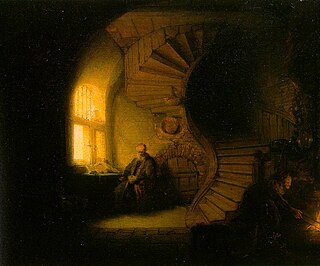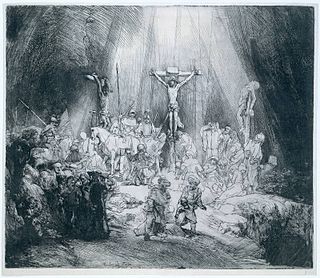
Adriaen van Ostade was a Dutch Golden Age painter of genre works, showing everyday life of ordinary men and women.

Simon de Vlieger was a Dutch painter, draughtsman and designer of tapestries, etchings, stained glass windows. While he is mainly known for his marine paintings he also painted beach scenes, landscapes and genre scenes.

The Descent from the Cross, or Deposition of Christ, is the scene, as depicted in art, from the Gospels' accounts of Joseph of Arimathea and Nicodemus taking Christ down from the cross after his crucifixion. In Byzantine art the topic became popular in the 9th century, and in the West from the 10th century. The Descent from the Cross is the 13th Station of the Cross, and is also the sixth of the Seven Sorrows of the Blessed Virgin Mary.

Giovanni Benedetto Castiglione was an Italian Baroque painter, printmaker and draftsman, of the Genoese school. He is best known now for his etchings, and as the inventor of the printmaking technique of monotyping. He was known as Il Grechetto in Italy and in France as Le Benédette.

Jan Lievens was a Dutch Golden Age painter who was associated with his close contemporary Rembrandt, a year older, in the early parts of their careers. They shared a birthplace in Leiden, training with Pieter Lastman in Amsterdam, where they shared a studio for about five years until 1631. Like Rembrandt he painted both portraits and history paintings, but unlike him Lievens' career took him away from Amsterdam to London, Antwerp, The Hague and Berlin.

Rembrandt Harmenszoon van Rijn, usually simply known as Rembrandt, was a Dutch Golden Age painter, printmaker, and draughtsman. An innovative and prolific master in three media, he is generally considered one of the greatest visual artists in the history of art. It is estimated Rembrandt produced a total of about three hundred paintings, three hundred etchings, and two thousand drawings.

Joachim Anthoniszoon Wtewael was a Dutch Mannerist painter and draughtsman, as well as a highly successful flax merchant, and town councillor of Utrecht. Wtewael was one of the leading Dutch exponents of Northern Mannerism, and his distinctive and attractive style remained largely untouched by the naturalistic developments happening around him, "characterized by masterfully drawn, highly polished figures often set in capricious poses". Wtewael was trained in the style of late 16th-century Haarlem Mannerism and remained essentially faithful to it, despite painting well into the early period of Dutch Golden Age painting.

Vincent van Gogh made many copies of other people's work between 1887 and early 1890, which can be considered appropriation art. While at Saint-Paul asylum in Saint-Rémy-de-Provence, France, where Van Gogh admitted himself, he strived to have subjects during the cold winter months. Seeking to be reinvigorated artistically, Van Gogh did more than 30 copies of works by some of his favorite artists. About twenty-one of the works were copies after, or inspired by, Jean-François Millet. Rather than replicate, Van Gogh sought to translate the subjects and composition through his perspective, color, and technique. Spiritual meaning and emotional comfort were expressed through symbolism and color. His brother Theo van Gogh would call the pieces in the series some of his best work.

Jacob Adriaensz Backer was a Dutch Golden Age painter. He produced about 140 paintings in twenty years, including portraits, religious subjects, and mythological paintings. In his style, he was influenced by Wybrand de Geest, Rubens and Abraham Bloemaert. He is also noted for his drawings of male and female nudes.

James Sidney Edouard, Baron Ensor was a Belgian painter and printmaker, an important influence on expressionism and surrealism who lived in Ostend for most of his life. He was associated with the artistic group Les XX.

The Conspiracy of Claudius Civilis is an oil painting by the Dutch painter Rembrandt, c. 1661–62, which was originally the largest he ever painted, at about five by five metres in the shape of a lunette. The painting was commissioned by the Amsterdam city council for the Town Hall. After the work had been in place briefly, it was returned to Rembrandt, who may have never been paid. Rembrandt drastically cut down the painting to a quarter of the original size to be sold. It is the last secular history painting he finished.

A tronie is a type of work common in Dutch Golden Age painting and Flemish Baroque painting that depicts an exaggerated or characteristic facial expression. These works were not intended as portraits or caricatures but as studies of expression, type, physiognomy or an interesting character such as an old man or woman, a young woman, the soldier, the shepherdess, the Oriental, or a person of a particular race.

The Hundred Guilder Print is an etching by Rembrandt. The etching's popular name derives from the large sum of money supposedly once paid for an example. It is also called Christ healing the sick, Christ with the Sick around Him, Receiving Little Children, or Christ preaching, since the print depicts multiple events from Matthew 19 in the New Testament, including Christ healing the sick, debating with scholars and calling on children to come to him. The rich young man mentioned in the chapter is leaving through the gateway on the right.

The Return of the Prodigal Son is an oil painting by Rembrandt, part of the collection of the Hermitage Museum in St. Petersburg. It is among the Dutch master's final works, likely completed within two years of his death in 1669. Depicting the moment of the prodigal son's return to his father in the Biblical parable, it is a renowned work described by art historian Kenneth Clark as "a picture which those who have seen the original in St. Petersburg may be forgiven for claiming as the greatest picture ever painted".

Philosopher in Meditation, recently renamed Philosopher in Contemplation by the museum, is the traditional title of an oil painting in the Musée du Louvre, Paris, that is attributed to the 17th-century Dutch artist Rembrandt.

The dozens of self-portraits by Rembrandt were an important part of his oeuvre. Rembrandt created approaching one hundred self-portraits including over forty paintings, thirty-one etchings and about seven drawings; some remain uncertain as to the identity of either the subject or the artist, or the definition of a portrait.

The Three Crosses is a 1653 print in etching and drypoint by the Dutch artist Rembrandt van Rijn, which depicts the crucifixion of Jesus Christ. Most of his prints are mainly in etching and this one is a drypoint with burin adjustments from the third state onwards. It is considered "one of the most dynamic prints ever made".

The Goldweigher's Field is a 1651 etching by Rembrandt now held by many museums, including the British Museum, the Rijksmuseum, and the Metropolitan Museum of Art. It is based on a landscape drawing in the collection of the Museum Boijmans van Beuningen.

In his late career in the 1650s, the Dutch artist Rembrandt created drawings that were inspired by miniatures from Mughal India. This was the only time the artist engaged with the artistic style of a "dramatically foreign culture". They depict Mughal emperors, noblemen, courtiers, and sometimes women and common folk. They were executed on expensive Asian or Japanese paper, and only 23 drawings survive today.

The Raising of Lazarus is an oil-on-canvas painting of 1631 by the Dutch artist Jan Lievens. The painting shows Jesus Christ raising Lazarus of Bethany from the dead. Its dimensions are 107 cm (42 in) × 114.3 cm (45.0 in).























